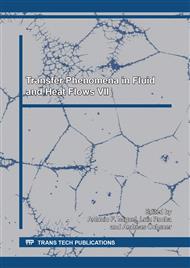p.23
p.32
p.41
p.53
p.64
p.71
p.83
p.91
p.99
Interfacial Tension and Viscosity Alteration of Samarium Doped Yttrium Iron Garnet (YIG) Nanofluid under the Presence of Electromagnetic Waves
Abstract:
A study is presented which implies the knowledge of rare earth magnetic anisotropy, nanotechnologies with the advancement of electromagnetic (EM) waves to induce alteration on oil-nanofluid interfacial tension (IFT) and nanofluid viscosity. The study had been done by doping of Samarium rare earth into Yttrium Iron Garnet (YIG) nanoparticles to improve the magnetic properties of the YIG nanoparticles. The doping process has been done by sol-gel method at 1000oC and at the pH of 7. Samarium rare earth was doped into YIG nanoparticles at different composition (x = 0.00, 0.25, 0.50, 0.75, 1.00). The results show that a Samarium doping composition at x =1.00 at pH 7 resulted in the highest nanofluid wettability, highest magnetic saturation, highest reduction in oil-water interfacial tension (IFT), and the highest alteration in viscosity. Moreover, overall of the experiment proved that when EM wave applied to the Samarium doped YIG nanofluid it had resulted in the increment of viscosity, more reduction in oil-water IFT. The experiment proved that Samarium doping into YIG nanoparticles/nanofluid (Sm-YIG) under the presence of electromagnetic waves are theoretically correct to alter oil-nanofluid IFT and nanofluid viscosity. This can be seen from the ability of Sm-YIG under the presence of EM waves effect on oil-water IFT reduction, nanofluid viscosity increment, reduction in oil-water mobility ratio and nanoparticles magnetic saturation increment.
Info:
Periodical:
Pages:
64-70
Citation:
Online since:
January 2019
Keywords:
Price:
Сopyright:
© 2019 Trans Tech Publications Ltd. All Rights Reserved
Share:
Citation:


